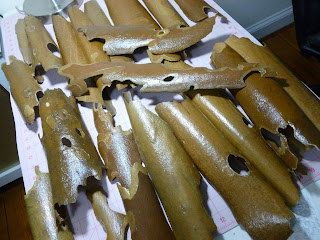I felt the author's intent was to make each chapter a meditation, with a transition to the next chapter. I tried to achieve the same effect with the various papers. Here is Scroll #3. As with the others, each 'scroll' is a three-section codex rolled to fit the curve of the bark when closed and fastened. Do I need to coin a new word? Scodex? Scrolodex?
Friday, October 23, 2015
Sunday, October 18, 2015
Leaning Sycamores Chapters 4 , 5, & 6
I thought a two-tone thread would look nice--like those black-and-gold caterpillars we find this time of year--so I chose black linen thread and gold silk thread, which constantly twisted as I ineptly tried to join the two curved pieces of bark. The "S" shape means the piercings for the inner curves must be closer together than the holes for the outer curves, which makes it harder to keep track of the pairs. I intended the "leaning S" as a play on the book's title, but to be honest the "S" more accurately stands for Stubborn (I refused to quit).
Wednesday, October 14, 2015
Leaning Sycamores, Chapters 1 through 3
It works!
This looks the way I envisioned it! But I have yet to decide
where to put the book title, author’s name, and chapter headings. I’m concerned
that lettering will ruin the effect. But for me it’s always all about the text,
so I will have to figure it out. For now I’ll focus on completing the next
three scrolls.
Tuesday, October 13, 2015
Leaning Sycamores, Part 1
 |
| Decoupaged bark, ready to assemble. |
 |
| Photos of tree trunks, and papers with inclusions, as chapter dividers. |
 |
| Closeup of sycamore tree trunk. |
 |
| This little creature gave me the idea to use a caterpillar stitch. |
 |
| Reflections |
Leaning Sycamores, Part 1
I chose Jack Wennerstrom’s Leaning Sycamores: Natural Worlds of the Upper Potomac to bind for the Potomac Chapter of the Guild of Book Workers exhibition, “Life Along the Potomac.” Darryl and I have taken our daughters to the river many times, and invited friends along. Now that we are empty nesters, we still enjoy walks along the towpath.
On page 42 the author describes the “scrolls” of bark that drop from sycamore trees. The shed bark looks like old leather—very much like that damaged Bible cover that I’d decoupaged a while ago. Underneath, the trunks are mottled in camouflage patterns of green, gray and gold.
Over the summer, I gathered sycamore bark and photographed the beautiful trunks. (I also found other remnants along the river: glass beer bottles, cans, plastic water bottles, discarded underwear and condoms.) My paper stash yielded papers with natural inclusions—pine needles, leaves, and ferns. A caterpillar making its way across the towpath at Great Falls became the inspiration for a caterpillar stitch. We shook pawpaw trees and picked up the fruits, whose seeds make beautiful natural buttons.
Because I wanted to use sycamore bark for the covers, standard bookmaking techniques wouldn’t work. The rectangular book shape couldn’t accommodate the cylinders of bark.
How to turn a codex into a scroll? Each chapter is a meditation on the natural world, so I took the book apart and re-made the signatures chapter by chapter. When done, I had 12 sections, divided into four groups. They can be easily curled into a scroll shape that fits the curve of the bark. I went through two bottles of Satin Mod Podge until I had collected and treated enough pieces to begin.
I’m sewing the covers on now. The November 1 deadline is less than three weeks away. I'll post photos when I'm finished.
Subscribe to:
Comments (Atom)






